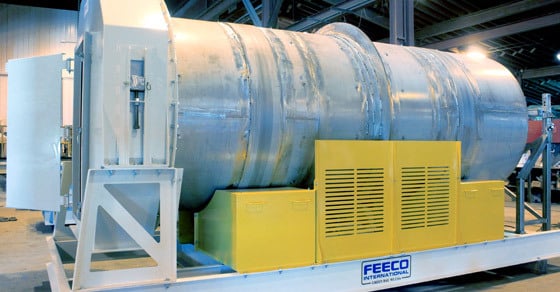The addition of a coating drum to a granulation line has gained popularity in recent years as producers look to further specialize their products and control quality and performance metrics. Whether producing a fertilizer product or roofing granules, the addition of a coating drum gives producers the opportunity to offer more specialized, premium products with a relatively low barrier to entry.
As producers across industries consider the addition of a coating drum to their production line, they often have a number of questions relating to infrastructure requirements, process and maintenance considerations, and even the coating drum itself.
With extensive experience in retrofitting plants with coating drums, FEECO offers the following guidance.
Infrastructure Requirements
While much of the infrastructure required to support a coating drum is already in place thanks to the existing granulation line, the addition of a coating drum will require a few further considerations.
Spatial Footprint
The most important consideration is incorporating the coating drum into the existing infrastructure with the allotted space.
Depending on the size of the coating drum, a unit may require anywhere from four to ten feet, up to 14 to 30 feet, and will need to be located after the dryer (or cooler, if applicable).
This may require relocating or modifying the downstream equipment configuration for packaging and loadout, adding on to the building, or the addition of a new floor in order to make room.
Feeding System
The production line will require a feeding system for transporting material from the dryer or cooler discharge to the coating drum. Depending on facility layout, this may be handled with a troughed belt conveyor, steep incline conveyor, bucket elevator, or combination thereof.
Coating Handling & Introduction
The coating itself will require a system for storing, preparing, and feeding the coating into the coating drum. Depending on the type of coating, this might include some type of liquid storage area, heater, filtration system, compressed air and pumps, as well as the drum internals and nozzles for distributing the coating onto the material bed.
Controls
A coating drum can be easily incorporated into the existing controls system. However, producers will need to implement a way to measure the raw material throughput. This is typically done with the use of a volumetric or gravimetric feeder. The coating must also be added in a controlled way to achieve the proper coating-to-product ratio.
Process Requirements
The addition of a coating drum is fairly simple in most aspects, due to the fact that it is implemented toward the end of the production line. However, there is one important consideration that cannot be overlooked: product screening must be located before the coating drum.
The ability to achieve a uniform coating depends largely on the uniformity of the incoming product; a wide particle size distribution or the inclusion of fines would be problematic and result in poor coating uniformity.
Maintenance Requirements
Coating drums have much the same maintenance requirements as other rotary drum equipment. However, the introduction of the coating component can increase the opportunity for buildup to occur in and around the drum, making buildup prevention and management an essential aspect of preventive maintenance.
Minimizing Buildup
Additional maintenance and more frequent inspections may be required to minimize any buildup that might occur before it has a chance to escalate into a more serious problem.
Buildup can occur in the drum, at the discharge chute, and at the nozzles. The coating filtration system may also require regular cleaning to prevent buildup.
Various types of liners can be incorporated into the drum to prevent material from sticking to the shell and causing buildup.
Training Operators
While operators and maintenance personnel are likely already familiar with the basic aspects of operating and maintaining rotary drum equipment, they may require additional training on the coating drum and its supporting equipment.
Coating Drum Considerations
The incorporation of a coating drum into an existing line requires significant attention, but it’s important to note that the design of the coating drum itself requires equal attention to ensure a solution that meets process and product goals.
Coating Drum Testing: Process Development
While coating is simple in theory, in practice it can quickly become complicated, as a number of variables must be carefully balanced to consistently achieve the desired results. For this reason, FEECO recommends testing in the Innovation Center in order to develop a working familiarity with the product and coating, as well as establishing data for scaleup.
The Innovation Center utilizes a pilot-scale coating drum to test and confirm process parameters such as:
- Coating and product feed rates
- Drum speed and slope
- Particle size distribution (PSD)
- Material pretreatment
- Coating and product temperatures
- Retention time
- Material bed action
- Spray nozzle type, location, and angle
Testing is particularly valuable in developing an optimized internal spray system, as well as evaluating drum liners and tumbling/agitation flights.
Variable Frequency Drive (VFD)
FEECO also recommends coating drums be equipped with a VFD, or variable frequency drive. A VFD not only gives the operator enhanced control over drum speed during start-up and shutdown, but it also helps in responding to fluctuations in the process. This often translates to lower energy costs, reduced wear on the drum, and decreased loss of product.
Conclusion
As more producers look to integrate a coating drum into their existing production line, they must consider various infrastructure, process, and maintenance requirements, as well as the design of the coating drum itself.
As the leading supplier of custom coating drums to various industries, FEECO offers plant managers a comprehensive solution to incorporating coating drums into existing granulation lines. This includes site audits and engineering support, process development testing, custom equipment manufacturing, and parts and service support. For more information, contact us today!



